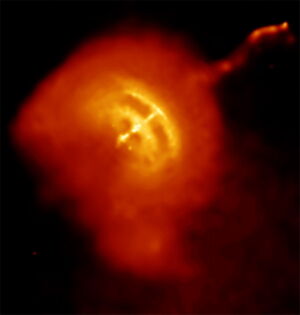
If you think black holes are the scariest things in the Universe, I have something to share with you.
There are balls of dead matter no bigger than a city yet shining a hundred times brighter than the Sun that send out flares of X-rays visible across the galaxy. Their interiors are made of superfluid subatomic particles, and they have cores of exotic and unknown states of matter. Their lifetime is only a few thousand years.
And here's the best part: They have the strongest magnetic fields ever observed, so strong they can melt you—literally dissociate you down to the atomic level—from a thousand kilometers away.
These are the magnetars, perhaps the most fearsome entities ever known.
Little green men
The best discoveries in science happen by accident, and to get to magnetars, we have to trace them through two unexpected observations.
The first came in 1967, when graduate student Jocelyn Bell (now Dame Jocelyn Bell Burnell) was working with her adviser, Antony Hewish, on the newly constructed and very fancy Interplanetary Scintillation Array at the Mullard Radio Astronomy Observatory in Cambridge, United Kingdom. While poring over one night's data, she found "a bit of scruff" (her words). It was a strikingly regular pattern, a flash of radio emission repeating every 1.33 seconds. Further observations showed that the signal came from the same point in the sky night after night, ruling out a terrestrial source.
At first, Bell and Hewish didn't know what to make of it. It was so regular and predictable that they half-jokingly called the source "LGM-1," wondering if "little green men" (i.e., aliens) might be responsible for the mysterious signal.

These objects came to be known as pulsars, a situation of pure coincidence. The rotating neutron star can emit beams of radiation that sweep out in circles like a lighthouse. When they flash over the Earth, we see them as a repeating pattern.
(In an unfortunate bit of history, Hewish won the Nobel prize for the discovery, but the committee excluded Bell.)
Around the same time, the United States Department of Defense launched a series of satellites, known as the Vela satellites, to monitor the Soviet Union for any naughtiness—specifically, any signs of violations of the nuclear test ban treaty. If the Soviets tested a nuclear bomb, it would release a flood of gamma rays that the Vela satellites could see from space.
The Vela satellites did indeed see a lot of flashes of gamma rays—but they came from the wrong direction. For years, the satellites monitored flash after flash coming from deep space and cataloged the mysterious events.
In 1973, the satellites finally let the astronomers in on the secret, and gamma-ray astronomy was born. After decades of study, astronomers realized that there were many different kinds of gamma-ray signals, with one in particular, the soft gamma repeaters, doing exactly what the name suggests: repeating.
To generate gamma rays (even the "soft" ones that are still incredibly powerful), you need a lot of energy, especially in the form of electromagnetic fields. And to make those emissions regular, you need something to be rotating. Astrophysicists realized that the best explanation for the origins of these soft gamma ray bursts was that they were beefed-up versions of pulsars, which would mean a highly magnetized neutron star.
In the 1990s, the concept of the magnetar was born.
reader comments
234